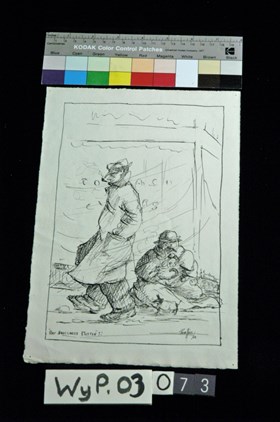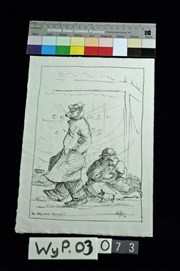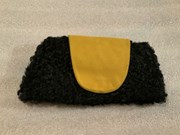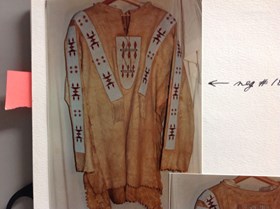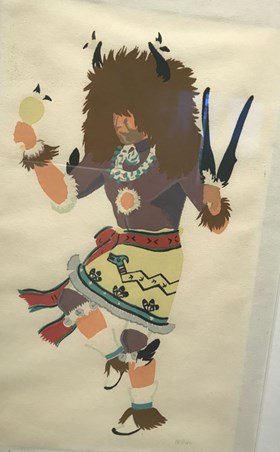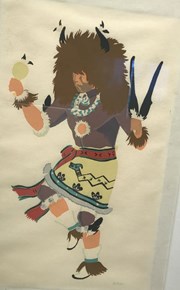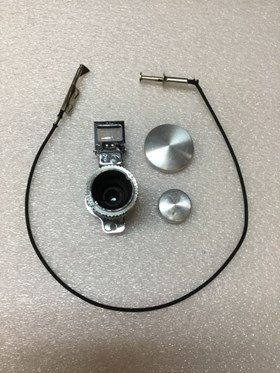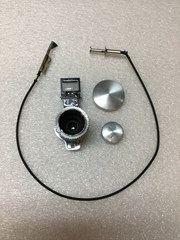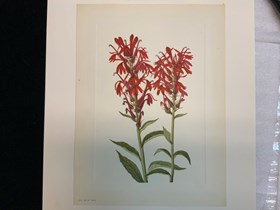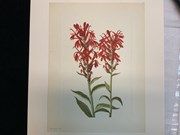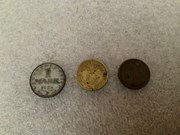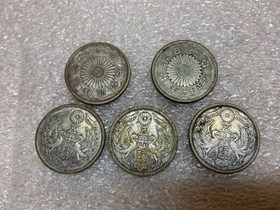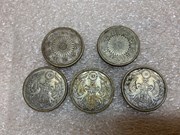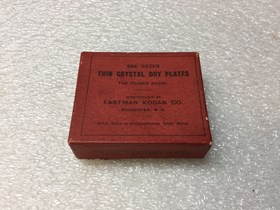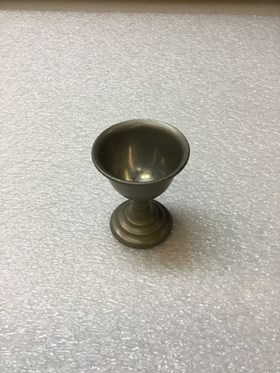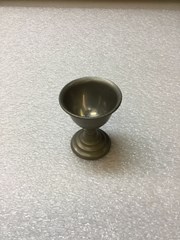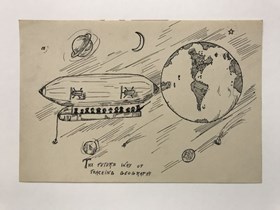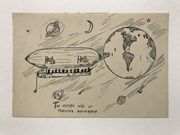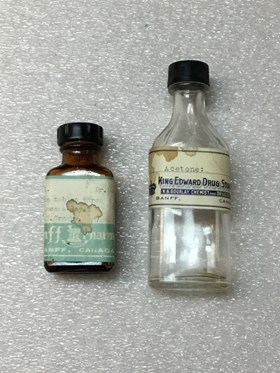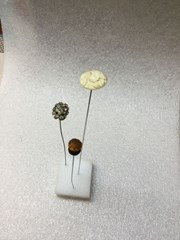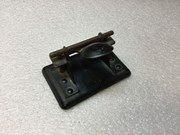Narrow Results By
- Peter Whyte (1905 – 1966, Canadian) 27
- Peter or Catharine Whyte 17
- Mary Vaux Walcott (1860 – 1940, American) 3
- Catharine Robb Whyte, O. C. (1906 – 1979, Canadian) 1
- Herbert C. Hahn (1907 – , American) 1
- John Arthur Fraser (1838 – 1898, English) 1
- Velino Herrera (1902 – 1973, American) 1
- Watanabe Bunzo (1853 – 1942, Japanese) 1
Any Shoelaces Mister?
https://archives.whyte.org/en/permalink/artifactwyp.03.073
- Date
- 1924
- Medium
- ink on paper
- Catalogue Number
- WyP.03.073
- Description
- Two men, one with pipe walking dog, one sitting. Obviously windy.
1 image
- Title
- Any Shoelaces Mister?
- Date
- 1924
- Medium
- ink on paper
- Dimensions
- 28.4 x 19.4 cm
- Description
- Two men, one with pipe walking dog, one sitting. Obviously windy.
- Credit
- Gift of Catharine Robb Whyte, O. C., Banff, 1975
- Catalogue Number
- WyP.03.073
Images
This material is presented as originally created; it may contain outdated cultural descriptions and
potentially offensive content.
Read more.
- Date
- 1920 – 1950
- Material
- hair, sheep; fibre
- Catalogue Number
- 103.04.0011
- Description
- A rectangular, narrow, straight sided hat of curly black lamb's wool. There is a crease down the centre of the crown, and a yellow wool flap that attaches to each side with hook snaps. The hat has a quilted black satin lining.
1 image
- Title
- Astrakhan
- Date
- 1920 – 1950
- Material
- hair, sheep; fibre
- Dimensions
- 15.0 x 4.0 x 28.5 cm
- Description
- A rectangular, narrow, straight sided hat of curly black lamb's wool. There is a crease down the centre of the crown, and a yellow wool flap that attaches to each side with hook snaps. The hat has a quilted black satin lining.
- Subject
- winter
- social customs
- Credit
- Gift of Pearl Evelyn Moore, Banff, 1979
- Catalogue Number
- 103.04.0011
Images
This material is presented as originally created; it may contain outdated cultural descriptions and
potentially offensive content.
Read more.
- Date
- 1885 – 1900
- Material
- skin, deer; glass; fibre
- Catalogue Number
- 103.05.1023
- Description
- Morning coat length bead-adorned shirt, fringed, notched collar with thongs, slits from bottom to armpits with thong ties, notched bottom edge and sleeves, bead pattern, white background, open geometric design with triangles, diamonds, and crosses of red, mauve and green, strips on sleeves from bre…
1 image
- Title
- Beaded Shirt
- Date
- 1885 – 1900
- Material
- skin, deer; glass; fibre
- Dimensions
- 55.0 x 89.0 cm
- Description
- Morning coat length bead-adorned shirt, fringed, notched collar with thongs, slits from bottom to armpits with thong ties, notched bottom edge and sleeves, bead pattern, white background, open geometric design with triangles, diamonds, and crosses of red, mauve and green, strips on sleeves from breast over shoulder to lower back (canvas backed), fringes on ends, buckskin backed swatches, solarplexus, back (fringed).
- Subject
- Indigenous
- clothing
- regalia
- beadwork
- Credit
- Gift of Pearl Evelyn Moore, Banff, 1969
- Catalogue Number
- 103.05.1023
Images
This material is presented as originally created; it may contain outdated cultural descriptions and
potentially offensive content.
Read more.
Buffalo Dancer
https://archives.whyte.org/en/permalink/artifacthev.07.01
- Date
- 1920 – 1960
- Medium
- watercolour on paper
- Catalogue Number
- HeV.07.01
- Description
- An man in full ceremonial regalia, bison headdress, yellow skirt with snake design, red sash, white moccasins with brown fringes, rattles in right hand and horns in left. He is dancing, standing on left leg.
1 image
- Title
- Buffalo Dancer
- Date
- 1920 – 1960
- Medium
- watercolour on paper
- Dimensions
- 23.0 x 12.5 cm
- Description
- An man in full ceremonial regalia, bison headdress, yellow skirt with snake design, red sash, white moccasins with brown fringes, rattles in right hand and horns in left. He is dancing, standing on left leg.
- Subject
- activity, dancing
- figure, male
- Credit
- Gift of Catharine Robb Whyte, O. C., Banff, 1979
- Catalogue Number
- HeV.07.01
Images
This material is presented as originally created; it may contain outdated cultural descriptions and
potentially offensive content.
Read more.
- Date
- c. 1930
- Material
- paper; plastic;
- Catalogue Number
- 104.41.0246
- Description
- A small black plastic camera, Univex Model A, in its original box with information sheet. The box is bright orange with black text and stripes along the box. Front of the box has an illustration of the camera in the top middle, with text surrounding that reads “UNIVEX PICTURES MAKE” “BEAUTIFUL ENLA…
1 image
- Title
- Camera
- Date
- c. 1930
- Material
- paper; plastic;
- Dimensions
- 6.6 x 9.1 x 5.0 cm
- Description
- A small black plastic camera, Univex Model A, in its original box with information sheet. The box is bright orange with black text and stripes along the box. Front of the box has an illustration of the camera in the top middle, with text surrounding that reads “UNIVEX PICTURES MAKE” “BEAUTIFUL ENLARGEMENTS”. Underneath the illustration in cursive text “Univex” and in regular text “A JEWEL OF A CAMERA” and in the bottom black stripe, “UNIVERSAL CAMERA CORPORATION” “MADE IN U.S.A.” “NEW YORK, N.Y.”. This is the same on the opposite side. Along the shorter side is more text “MODEL A” “Univex” “CAMERA”, a stamp that reads “UNIVERSAL CAMERA COMPANY HERMANT BLOG. TORONTO, — CANADA”, and “MADE IN U.S.A.” The top and bottom of the box just read “MODEL A” “Univex” “CAMERA”. Inside the box is a small information sheet with pricing of rolls for the camera, printing and developing. The camera is small with a long square lens, a metal wire range finder that lines up with the smaller range finder attached to the side of the camera. The shutter is one the side of the lens, fairly small. There is a metal knob to wind the film. The back of the camera features raised text, “Univex” “USE UNIVEX No 00 FILM ROLLS ONLY” in a square, a red circle with “MADE IN UNITED STATES OF AMERICA”, “MODEL A CAMERA U.S. PAT. DES. 89.88 OTHER U.S. AND FOR’G’N PATSPOG” in a square, and “UNIVERSAL CAMERA CORPORATION NEW YORK, N.Y., U.S.A.”. The inside of the camera has a spot for film.
- Credit
- Gift of Don Harmon, Banff, 1985
- Catalogue Number
- 104.41.0246
Images
This material is presented as originally created; it may contain outdated cultural descriptions and
potentially offensive content.
Read more.
Camera Accessories
https://archives.whyte.org/en/permalink/artifact104.41.0185%20a%2cb
- Date
- 1923 – 1940
- Material
- metal; glass; fabric;
- Catalogue Number
- 104.41.0185 a,b
- Description
- Silver metal Kodak lens with mounting plate that includes a fold-up view finder [possibly for a Ciné-Kodak motion picture camera] with black velvet-lined lens caps and a black fabric-wrapped extension trigger for an unknown camera.
1 image
- Title
- Camera Accessories
- Date
- 1923 – 1940
- Material
- metal; glass; fabric;
- Dimensions
- 4.2 x 4.1 x 9.6 cm
- Description
- Silver metal Kodak lens with mounting plate that includes a fold-up view finder [possibly for a Ciné-Kodak motion picture camera] with black velvet-lined lens caps and a black fabric-wrapped extension trigger for an unknown camera.
- Credit
- Gift of Robert Crosby Family, Banff, 1998
- Catalogue Number
- 104.41.0185 a,b
Images
This material is presented as originally created; it may contain outdated cultural descriptions and
potentially offensive content.
Read more.
Canadian Blue Ensign Flag
https://archives.whyte.org/en/permalink/artifact109.02.1015
- Date
- 1921 – 1957
- Material
- fabric; rope; metal
- Catalogue Number
- 109.02.1015
- Description
- A fabric Canadian Blue Ensign flag with a metal hook attached to the top left corner and a metal loop attached to a rope, attached to the bottom left corner. The main colour of the flag is royal blue. A red, white and blue union flag occupied the top left quarter. In the top right quarter, is a Coa…
1 image
- Title
- Canadian Blue Ensign Flag
- Date
- 1921 – 1957
- Material
- fabric; rope; metal
- Dimensions
- 44.0 x 94.0 cm
- Description
- A fabric Canadian Blue Ensign flag with a metal hook attached to the top left corner and a metal loop attached to a rope, attached to the bottom left corner. The main colour of the flag is royal blue. A red, white and blue union flag occupied the top left quarter. In the top right quarter, is a Coat of Arms of Canada, characterized by its five sections: the three golden lions on red; the single red lion on gold; the golden harp on blue; the three golden fleur de lis on blue; and the three green maple leaves on white.There is a manufacturer’s label stitched on the top-left edge, reading: MADE BY/ S.S. HOLDEN / LTD./ OTTAWAThis text is red and appears within a red drawing of what looks like a tent’s side.Below this label, the black letters BR are stamped onto the fabric.
- Credit
- Gift of Brian Wing, Calgary, 2015
- Catalogue Number
- 109.02.1015
Images
This material is presented as originally created; it may contain outdated cultural descriptions and
potentially offensive content.
Read more.
Cardinal Flower
https://archives.whyte.org/en/permalink/artifactwam.04.09
- Date
- 1925
- Medium
- ink on paper
- Catalogue Number
- WaM.04.09
- Description
- Reproduction print from Mary Vaux Wallcott’s North American wildflowers book. Print shows two stems with long-petalled red flowers. “263 M V W 1925” is printed in blue in lower left corner.
1 image
- Title
- Cardinal Flower
- Date
- 1925
- Medium
- ink on paper
- Dimensions
- 31.5 x 23.5 cm
- Description
- Reproduction print from Mary Vaux Wallcott’s North American wildflowers book. Print shows two stems with long-petalled red flowers. “263 M V W 1925” is printed in blue in lower left corner.
- Credit
- Gift of Bobbye Ruth Potter, 2012
- Catalogue Number
- WaM.04.09
Images
This material is presented as originally created; it may contain outdated cultural descriptions and
potentially offensive content.
Read more.
Cathedral Mountain In Yoho
https://archives.whyte.org/en/permalink/artifacthah.03.02
- Date
- 1928
- Medium
- graphite on paper
- Catalogue Number
- HaH.03.02
- Description
- General colour: black on white. In the foreground is a lake and ten trees on the opposite shore. Beyond is a treed slope up to rocky peaks. Behind is cloudy sky.
- Title
- Cathedral Mountain In Yoho
- Date
- 1928
- Medium
- graphite on paper
- Dimensions
- 20.3 x 25.4 cm
- Description
- General colour: black on white. In the foreground is a lake and ten trees on the opposite shore. Beyond is a treed slope up to rocky peaks. Behind is cloudy sky.
- Subject
- landscape
- mountains
- Cathedral mOuntain
- Credit
- Gift of Iva (Mrs. Len) Smith, 1976
- Catalogue Number
- HaH.03.02
This material is presented as originally created; it may contain outdated cultural descriptions and
potentially offensive content.
Read more.
- Date
- 1925 – 1950
- Material
- metal; aluminum; wood;
- Catalogue Number
- 104.19.0272
- Description
- Tall cylindrical aluminum coffee maker/pot with an ventilation cap that fits on top and an internal filter. The main body has a wooden handle screwed into one side, with a short spout opposite it - throughout the portion of the coffee maker that is covered by the spout are small holes. The cap has …
1 image
- Title
- Coffee Maker
- Date
- 1925 – 1950
- Material
- metal; aluminum; wood;
- Dimensions
- 27.5 x 11.2 x 19.1 cm
- Description
- Tall cylindrical aluminum coffee maker/pot with an ventilation cap that fits on top and an internal filter. The main body has a wooden handle screwed into one side, with a short spout opposite it - throughout the portion of the coffee maker that is covered by the spout are small holes. The cap has two roughly-triangular groupings of ventilation holes opposite from each other and the domed top is capped with a small wooden handle. Inside the coffee maker is a metal filter that consists of a thin pole supported by a slightly domed base with a lip just above the middle on which sits the removable filter. No manufacturer details could be found.
- Subject
- coffee maker
- drinks
- kitchen utensil
- Credit
- Gift of Bill Mather, Edmonton, 1991
- Catalogue Number
- 104.19.0272
Images
This material is presented as originally created; it may contain outdated cultural descriptions and
potentially offensive content.
Read more.
- Date
- 1924 – 1938
- Material
- metal
- Catalogue Number
- 109.03.0016 a-c
- Description
- Three German coins. a) round silver coin, 2.2 cm x 2.2 cm. Front: An Imperial eagle - wings outstretched and facing left. Reverse: “1 MARK 1924”, “DEUTSCHES REICH” around outside, mintmark at bottomb) round brass coin, 2.0 cm x 2.0 cm. Front: An eagle above the swastika within wreath. “Deutsches Re…
1 image
- Title
- Coin Money
- Date
- 1924 – 1938
- Material
- metal
- Dimensions
- 2.2 x 2.2 cm
- Description
- Three German coins. a) round silver coin, 2.2 cm x 2.2 cm. Front: An Imperial eagle - wings outstretched and facing left. Reverse: “1 MARK 1924”, “DEUTSCHES REICH” around outside, mintmark at bottomb) round brass coin, 2.0 cm x 2.0 cm. Front: An eagle above the swastika within wreath. “Deutsches Reich 1939” around bottom edge. Back: “Reichspfennig 10” and two oak leaves. c) round copper coin, 2.0 cm x 2.0 cm. Front: A wheatsheaf dividing the date (1924). Mintmark (A) below. Back: “2” in centre inside a circle. Inscription “DEUTSCHES REICH RENTENPFENNIG” around.
- Subject
- Whyte home
- currency
- Credit
- Gift of Catharine Robb Whyte, O. C., Banff, 1979
- Catalogue Number
- 109.03.0016 a-c
Images
This material is presented as originally created; it may contain outdated cultural descriptions and
potentially offensive content.
Read more.
- Date
- 1922 – 1938
- Material
- metal
- Catalogue Number
- 109.03.0009 a-e
- Description
- Japanese 50-Sen coins. Obverse: Cherry blossoms and Japanese characters. Reverse: Pair of phoenix, chrysanthemum, Japanese characters.
1 image
- Title
- Coin Money
- Date
- 1922 – 1938
- Material
- metal
- Dimensions
- 2.3 x 2.3 cm
- Description
- Japanese 50-Sen coins. Obverse: Cherry blossoms and Japanese characters. Reverse: Pair of phoenix, chrysanthemum, Japanese characters.
- Subject
- Whyte home
- money
- Japan
- Credit
- Gift of Catharine Robb Whyte, O. C., Banff, 1979
- Catalogue Number
- 109.03.0009 a-e
Images
This material is presented as originally created; it may contain outdated cultural descriptions and
potentially offensive content.
Read more.
- Date
- 1920 – 1940
- Material
- cardboard; paper; glass;
- Catalogue Number
- 104.41.0220
- Description
- Box of one dozen Thin Crystal Dry Plates for a Pocket Kodak camera. The box’s seal has been broken - inside are alternating layers of thin black paper and the glass plates, which are fogged.Dry plate, or the gelatin process, was invented by Dr. Richard L. Maddox in 1871 and replaced the more time-c…
1 image
- Title
- Dry Plates
- Date
- 1920 – 1940
- Material
- cardboard; paper; glass;
- Dimensions
- 1.9 x 6.0 x 5.1 cm
- Description
- Box of one dozen Thin Crystal Dry Plates for a Pocket Kodak camera. The box’s seal has been broken - inside are alternating layers of thin black paper and the glass plates, which are fogged.Dry plate, or the gelatin process, was invented by Dr. Richard L. Maddox in 1871 and replaced the more time-consuming wet plate, or collodion process, which required active wet chemicals to be prepared in mobile dark rooms. The dry plate process underwent several adaptations throughout the 1870s and, in 1879, George Eastman developed a method of applying the emulsion layer to glass in a factory setting, simultaneously creating what came to be known as the Eastman Kodak Co. and bringing down the cost of photography so as to be accessible to the masses.
- Subject
- photography
- photographic equipment
- Credit
- Gift of Catharine Robb Whyte, O. C., Banff, 1979
- Catalogue Number
- 104.41.0220
Images
This material is presented as originally created; it may contain outdated cultural descriptions and
potentially offensive content.
Read more.
- Date
- 1920 – 1930
- Material
- metal;
- Catalogue Number
- 104.20.1295
- Description
- Metal eggcup with a hollow base and fluted stand below the cup, which has a slightly curved-out lip.
1 image
- Title
- Eggcup
- Date
- 1920 – 1930
- Material
- metal;
- Dimensions
- 5.9 cm
- Description
- Metal eggcup with a hollow base and fluted stand below the cup, which has a slightly curved-out lip.
- Subject
- kitchen utensils
- Credit
- Gift of Bill Mather, Edmonton, 1991
- Catalogue Number
- 104.20.1295
Images
This material is presented as originally created; it may contain outdated cultural descriptions and
potentially offensive content.
Read more.
- Date
- 1920 – 1945
- Material
- metal; glass; plastic;
- Catalogue Number
- 104.41.0171 a-c
- Description
- Four pieces from different manufacturers that make up a viewer for 16mm film, includes:Zeiss Moviscop : a grey-blue metal machine with a small square screen above the mechanism that feeds the film through and illuminates it from below. On the left-hand side is an outlet where the power cord can be …
1 image
- Title
- Film Viewer
- Date
- 1920 – 1945
- Material
- metal; glass; plastic;
- Dimensions
- 25.9 x 14.5 x 7.6 cm
- Description
- Four pieces from different manufacturers that make up a viewer for 16mm film, includes:Zeiss Moviscop : a grey-blue metal machine with a small square screen above the mechanism that feeds the film through and illuminates it from below. On the left-hand side is an outlet where the power cord can be plugged in [power cord missing], and on the right-hand side is a a black plastic knob [possibly for feeding the film] and a switch.Moviloa [Hollywood, California, USA] : two grey metal film reel holders with wooden handles. Placed on either side of the viewing machine, these holders were used to hold the two ends of the film reel. CIR-Catozzo [Leo Catozzo of Rome, Italy] : grey metal film splicer. Consists of a plate that hinges upward with a black plastic handle so that the film [16mm] can be inserted, two hinged slicers on the right-hand side [one of which is on an angle], and a roll of clear adhesive tape mounted at the front. On the bottom of the splicer is a piece of masking tape that has HH Films written in blue ink.
- Credit
- Gift of Eddie Hunter, Banff, 1995
- Catalogue Number
- 104.41.0171 a-c
Images
This material is presented as originally created; it may contain outdated cultural descriptions and
potentially offensive content.
Read more.
- Date
- ca. 1926 – 1932
- Material
- metal; glass; leather; plastic
- Catalogue Number
- 104.41.0255 a,b
- Description
- A No.1A Pocket Kodak with camera case. a) Black camera with embellished details in the outer covering. On the top, there is a leather handle which reads “KODAK” and is attached to the camera with metal hinges. At the back of the camera is a red glass window. There is also a small opening with a tab…
1 image
- Title
- Folding Camera
- Date
- ca. 1926 – 1932
- Material
- metal; glass; leather; plastic
- Dimensions
- 20.9 x 8.7 x 3.7 cm
- Description
- A No.1A Pocket Kodak with camera case. a) Black camera with embellished details in the outer covering. On the top, there is a leather handle which reads “KODAK” and is attached to the camera with metal hinges. At the back of the camera is a red glass window. There is also a small opening with a tab that can slide open; this is an autographic window which would have allowed the photographer to add handwritten notes into the film negative with a stylus, which would have been included with the camera. There is a tab at the top of the camera that would be used for winding the film. On the back of the camera is an embellished logo reading “USE KODAK FILM No. A116” in a circular motif. The sides of the camera are rounded. On the front is a panel that opens by releasing the latch just above the panel. The front panel has a small hole in it with threads, suggesting that something could be screwed into it like a tripod. There is also a tripod hole on the bottom of the camera. On the outside of the front panel is a metal label with the text: “Kodak” written in embellished script. This label is a metal tab that folds out and operates as a stand for the camera to sit upright. On the back of the kickstand is engraved with the number “132743”. When opened, the inside of the panel door has a metal track. There is also metal hardware such as a screw mechanism that can be spun to move the metal track forward to adjust the viewing distance. On the right is a metal gauge with various distances in feet and meters. When the track is adjusted, a notch in the side of it lines up with the lines on the gauge. The panel door is attached with an elaborate brace that locks to keep the door in an open position. There is a metal knob that can be pulled forward to extend the lens and unfold the lens hood. The lens is connected with a metal frame. There are decorative labels attached to the lens frame. Above the lens is a label that reads: “KODEX” and has a logo reading “EKC” in an art deco font. The label also has shutter speeds. Beside the frame is the metal shutter release, which can be pushed down to activate the shutter. On the right is the viewfinder which can be viewed from above or the side by flipping it on its hinge. Small text below the lens reads: “SHUTTER MADE IN ROCHESTER, N.Y., U.S.A. BY”, “EASTMAN KODAK CO.” On the left side of this lower label are the numbers “29061”. There are also aperture settings along the bottom, which can be adjusted by moving the small arrow. Below the lens and its frames is another label which reads, “NO. 1A POCKET KODAK”; “MADE IN CANADA BY”; “CANADIAN KODAK CO.”; “LIMITED”; “TORONTO ONTARIO”. The lens is extended outward by press a small metal button next to the right side of the lens while using the small silver knob to guide. Outside, on the front of the camera, the metal hardware below the panel door can be lifted to release the entire interior cartridge in order to load film into the camera. The interior back panel is plastic and has a series of patent dates and patent numbers for USA, Canada, Australia, and Britain.b) A medium sized dark brown leather camera bag with a short strap with one metal buckle. On the front of the bag is a metal clasp with “CKC” (Canadian Kodak Co., Limited logo) and a lever to release the clasp. Above the clasp is stamped with “MADE IN U.S.A.” 22.1 x 9.8 x 4.4 cm.
- Subject
- film photography
- photography
- Kodak
- camera
- Credit
- Gift of Elaine Maxwell, Banff, 1984
- Catalogue Number
- 104.41.0255 a,b
Images
This material is presented as originally created; it may contain outdated cultural descriptions and
potentially offensive content.
Read more.
The Future way of Teaching Geography
https://archives.whyte.org/en/permalink/artifactwyp.03.928
- Date
- 1925 – 1966
- Medium
- graphite; ink on paper
- Catalogue Number
- WyP.03.928
- Description
- An blimp/Zeppelin carries a group of people in space where they are looking at the different planets and stars, though Earth is the most prominent in the sky. Below the drawing it says “THE FUTURE WAY OF TEACHING GEOGRAPHY”
1 image
- Title
- The Future way of Teaching Geography
- Date
- 1925 – 1966
- Medium
- graphite; ink on paper
- Dimensions
- 15.0 x 22.5 cm
- Description
- An blimp/Zeppelin carries a group of people in space where they are looking at the different planets and stars, though Earth is the most prominent in the sky. Below the drawing it says “THE FUTURE WAY OF TEACHING GEOGRAPHY”
- Subject
- airship
- blimp
- Zeppelin
- aircraft
- flying
- space
- travel
- people
- passengers
- education
- star
- planet
- Earth
- geography
- Credit
- Gift of Catharine Robb Whyte, O. C., Banff, 1979
- Catalogue Number
- WyP.03.928
Images
This material is presented as originally created; it may contain outdated cultural descriptions and
potentially offensive content.
Read more.
- Date
- 1920 – 1940
- Material
- glass; plastic; paper;
- Catalogue Number
- 110.01.0288 a,b
- Description
- Two glass drug store bottles with black plastic caps and paper adhesive labels on the front:a - tall and narrow clear glass bottle with a “KING EDWARD DRUG STORE” paper adhesive label on the front - “Acetone” is typed along the top of the label. Molded onto the back of the bottle are measurement ma…
1 image
- Title
- Glass Bottles
- Date
- 1920 – 1940
- Material
- glass; plastic; paper;
- Dimensions
- 12.1 x 2.6 x 4.1 cm
- Description
- Two glass drug store bottles with black plastic caps and paper adhesive labels on the front:a - tall and narrow clear glass bottle with a “KING EDWARD DRUG STORE” paper adhesive label on the front - “Acetone” is typed along the top of the label. Molded onto the back of the bottle are measurement markers.b - short and narrow brown glass bottle with a “Banff Pharmacy” paper adhesive label on the front - the label has typed instructions for taking tablet medication.
- Subject
- Crosby family
- Abegweit
- medicine
- drug store
- pharmacy
- Credit
- Gift of Robert Crosby Family, Banff, 1998
- Catalogue Number
- 110.01.0288 a,b
Images
This material is presented as originally created; it may contain outdated cultural descriptions and
potentially offensive content.
Read more.
- Date
- 1880 – 1920
- Material
- metal; glass; plastic;
- Catalogue Number
- 103.01.0350 a-c
- Description
- Three hatpins of three different styles [two are the same length, the third is longer]: one is a cluster of cut white gems [probably fake] set in gold in the shape of a bouquet of flowers; one is pale plastic cameo-style with a flat bottom and a flower on the top; one is a round dark metal base cov…
1 image
- Title
- Hatpin
- Date
- 1880 – 1920
- Material
- metal; glass; plastic;
- Dimensions
- 2.7 x 27.7 cm
- Description
- Three hatpins of three different styles [two are the same length, the third is longer]: one is a cluster of cut white gems [probably fake] set in gold in the shape of a bouquet of flowers; one is pale plastic cameo-style with a flat bottom and a flower on the top; one is a round dark metal base covered in little bumps with a cut yellow glass topper.
- Credit
- Gift of Robert Crosby Family, Banff, 1998
- Catalogue Number
- 103.01.0350 a-c
Images
This material is presented as originally created; it may contain outdated cultural descriptions and
potentially offensive content.
Read more.
- Date
- 1886 – 1940
- Material
- metal;
- Catalogue Number
- 105.06.0096
- Description
- Black metal two hole punch with a round compression lever and a collection tray underneath that hinges open. On the bottom is a small piece of adhesive fabric tape with “M West. Phal” written on it.German Friedrich Soennecken is credited with inventing the two hole punch in 1886.
1 image
- Title
- Hole Punch
- Date
- 1886 – 1940
- Material
- metal;
- Dimensions
- 7.3 x 7.7 x 11.6 cm
- Description
- Black metal two hole punch with a round compression lever and a collection tray underneath that hinges open. On the bottom is a small piece of adhesive fabric tape with “M West. Phal” written on it.German Friedrich Soennecken is credited with inventing the two hole punch in 1886.
- Subject
- office supplies
- stationary
- Credit
- Gift of Bill Mather, Edmonton, 1991
- Catalogue Number
- 105.06.0096
Images
This material is presented as originally created; it may contain outdated cultural descriptions and
potentially offensive content.
Read more.

